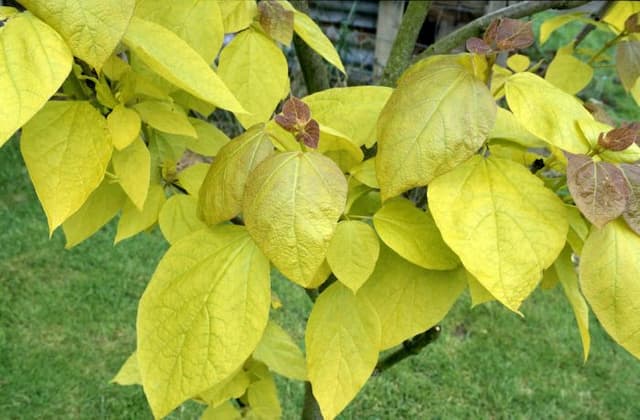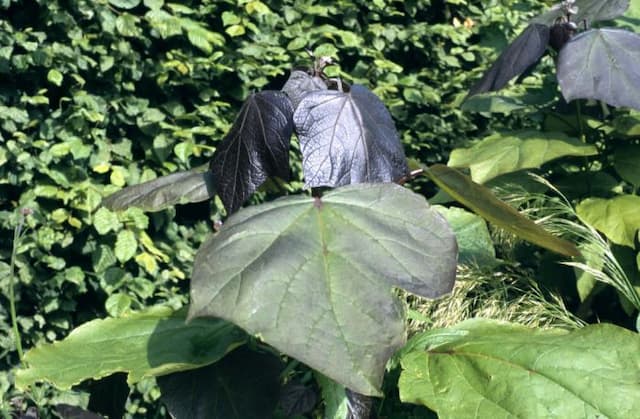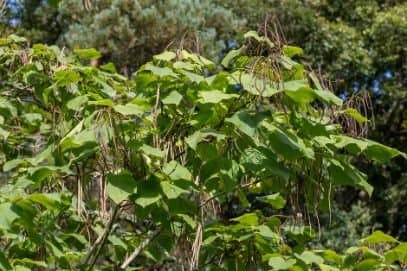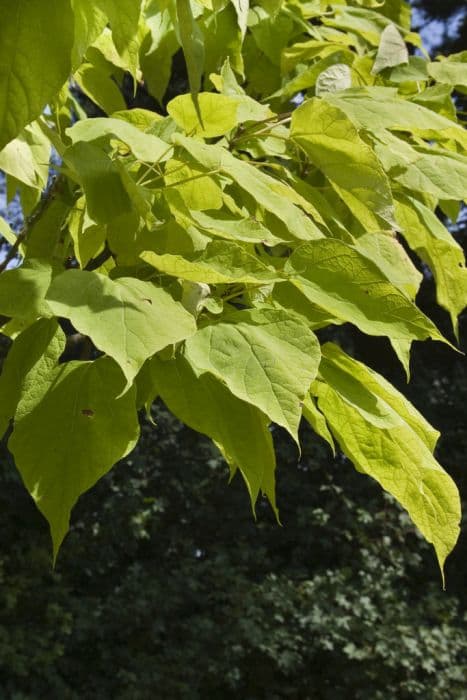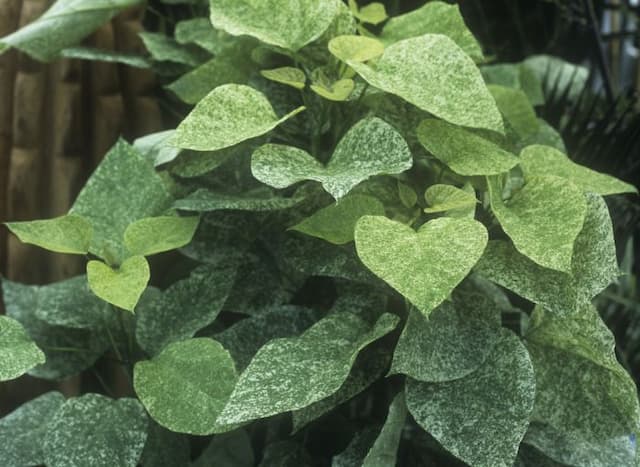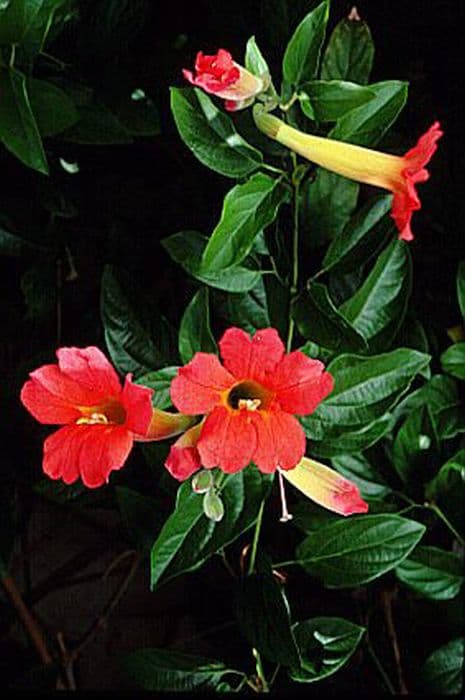Hardy gloxinia Incarvillea delavayi
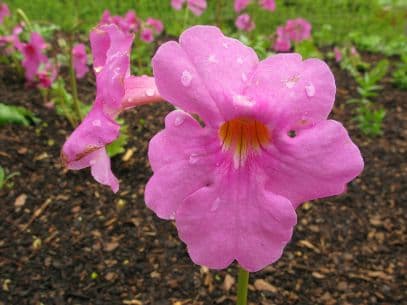
ABOUT
Incarvillea delavayi, commonly known as the hardy gloxinia, is a perennial plant noted for its striking flowers and lush foliage. The leaves of this plant are pinnately divided, meaning they consist of a central stem with smaller leaflets arranged on either side. These leaflets are generally lance-shaped, with a pointed tip and a plush green hue that offers a verdant backdrop to the blossoms. The flowers of the hardy gloxinia are its most remarkable feature, large and showy with a trumpet-like form that beckons attention. These blooms are typically a deep pink to rose color, and may exhibit a yellow to white throat, which adds to the visual interest. The petals are velvety and often have a delicate, crepe-paper-like texture, while the stamens inside the flower tube contribute a subtle contrast. This plant displays a bushy growth habit, with multiple stems emerging from the base, each hosting clusters of the distinctive flowers. The hardy gloxinia's leafy stems and bright blooms combine to create an impactful display in gardens or as a featured plant in various settings. The overall appearance of the hardy gloxinia is one of lushness and color, making it a prized addition for its ornamental value.
About this plant
 Names
NamesFamily
Bignoniaceae
Synonyms
Hardy Gloxinia, Chinese Trumpet Flower
Common names
Incarvillea zhongdianensis, Incarvillea megacalyx, Incarvillea sinensis.
 Toxicity
ToxicityTo humans
Incarvillea delavayi, commonly known as the hardy gloxinia, does not have well-documented toxicity to humans. However, as with any plant, it is generally advised not to ingest parts of plants that are not known to be edible, since they could potentially cause an adverse reaction. If Hardly Gloxinia is ingested and symptoms of poisoning occur, medical attention should be sought. Symptoms of plant poisoning can include gastrointestinal discomfort, nausea, vomiting, or more severe reactions depending on the individual’s sensitivity and the amount ingested.
To pets
Hardly Gloxinia is not widely known to be toxic to pets, but it is generally recommended to discourage pets from eating plants not intended for consumption. If a pet does ingest portions of Hardly Gloxinia and shows signs of illness such as vomiting, diarrhea, drooling, or any unusual behavior, it is important to consult a veterinarian promptly. These symptoms could indicate poisoning or an allergic reaction, and a timely veterinary assessment would be crucial to ensure the well-being of the animal.
 Characteristics
CharacteristicsLife cycle
Perennials
Foliage type
Deciduous
Color of leaves
Green
Flower color
Pink
Height
2 feet (60 cm)
Spread
2 feet (60 cm)
Plant type
Herb
Hardiness zones
5
Native area
China
Benefits
 General Benefits
General Benefits- Ornamental Appeal: Incarvillea delavayi, commonly known as hardy gloxinia, has showy trumpet-shaped flowers that enhance the visual appeal of gardens and landscapes.
- Low Maintenance: Hardy gloxinia is known for being easy to care for, requiring minimal attention once established.
- Drought Tolerance: Once established, it is relatively drought-tolerant, making it suitable for gardens in drier climates or for water-wise landscaping.
- Attracts Pollinators: The bright flowers attract bees and other pollinators, which are beneficial for the health of the garden ecosystem.
- Container Gardening: Due to its compact size, hardy gloxinia is suitable for container gardening, allowing it to be placed on patios, balconies, or small spaces.
- Deer Resistance: Hardy gloxinia is considered deer-resistant, which is an advantage in areas where deer browsing can harm garden plants.
 Medical Properties
Medical Properties- Analgesic - Incarvillea delavayi may possess pain-relieving properties.
- Anti-inflammatory - The plant may have components that help reduce inflammation.
- Diuretic - It may promote diuresis to help remove excess water from the body.
 Air-purifying Qualities
Air-purifying QualitiesThis plant is not specifically known for air purifying qualities.
 Other Uses
Other Uses- Incarvillea delavayi, commonly known as the hardy gloxinia, can be used as a natural fabric dye, providing a range of colors from the flowers and roots depending on the mordant used.
- The plant can be utilized in garden design to attract pollinators like bees and butterflies, thereby supporting local ecosystems.
- Hardy gloxinia's stems and leaves can be incorporated into art projects, such as in pressed flower crafts or botanical prints.
- Because of its unique appearance, the plant is sometimes utilized in photography as a subject for botanical and garden themed images.
- It can be planted in outdoor containers where other plants might struggle, given its tolerance for tough garden conditions.
- The plant's flowers can be used in educational settings to study the morphology and reproductive system of Angiosperms.
- In landscape architecture, hardy gloxinia can be used as a flowering ground cover to prevent soil erosion on slopes.
- During off-seasons, the seed pods can add visual interest to winter gardens with their distinctive shapes and textures.
- The plant can be used in themed gardens, such as moon gardens, with its pale flowers reflecting moonlight and creating a luminous effect at night.
- In culinary use, the flowers may be candied or used as edible decorations on desserts, though one should always ensure that flowers used this way are safe and free of pesticides.
Interesting Facts
 Feng Shui
Feng ShuiThe Incarvillea delavayi, commonly known as the Hardy Gloxinia, is not used in Feng Shui practice.
 Zodiac Sign Compitability
Zodiac Sign CompitabilityThe Hardy Gloxinia is not used in astrology practice.
 Plant Symbolism
Plant Symbolism- Resilience: Incarvillea delavayi, commonly known as the hardy gloxinia, can thrive in challenging environments, making it a symbol of strength and the ability to overcome adversity.
- Isolation: Hardy gloxinia, often found in sparse, rocky areas, represents solitude and the beauty of standing alone.
- Rare Beauty: With its striking blooms, the hardy gloxinia symbolizes unique beauty that stands out in its rarity and distinctiveness.
- Survival: Its capability to survive with minimal water and poor soil conditions makes it a symbol of survival and self-sufficiency.
 Water
WaterHardy Gloxinia should be watered when the top inch of soil begins to feel dry, which typically means watering once every 7 to 10 days. Use a watering can to apply water slowly at the base of the plant, avoiding wetting the foliage, with about 1 gallon of water per plant during each watering session. In hotter, drier periods, increase watering frequency, but always allow the soil to dry slightly between waterings to prevent waterlogging. Avoid overwatering as it can lead to root rot, a common issue with these plants.
 Light
LightHardy Gloxinia thrives in partial shade or an area that receives filtered sunlight. The ideal location would be a spot that is bright in the morning with some afternoon shade, or under the dappled light of taller trees or structures. Direct afternoon sunlight can be too intense and may scorch the leaves, so it's essential to find a balance of light and shade.
 Temperature
TemperatureHardy Gloxinia prefers temperatures between 60 and 75 degrees Fahrenheit, although it can survive brief periods of higher or lower temperatures. The plant is winter hardy in USDA zones 5 through 9, which means it can survive minimum temperatures down to -20 to -10 degrees Fahrenheit. For optimal growth, avoid exposing Hardy Gloxinia to temperatures below 50 degrees Fahrenheit for extended periods.
 Pruning
PruningPrune Hardy Gloxinia to remove spent flowers and dead leaves, which encourages new growth and blooms. This maintenance can be performed throughout the growing season as needed. The best time to conduct a more thorough pruning is in the late winter or early spring before new growth begins, cutting back any dead or damaged stems to maintain plant health and shape.
 Cleaning
CleaningAs needed
 Soil
SoilThe Hardy Gloxinia thrives in well-draining, fertile soil with a pH range of 6.0 to 7.0. A mix of loam, peat, and sand in equal parts with a handful of compost provides an optimal growing medium for this plant.
 Repotting
RepottingHardy Gloxinia should be repotted every 2 to 3 years to refresh the soil and accommodate the growth of its tubers. Choose a slightly larger pot each time to ensure proper root expansion.
 Humidity & Misting
Humidity & MistingHardy Gloxinia prefers moderate humidity levels. While it can adapt to lower humidity, try to maintain an environment similar to its natural habitat which typically involves a good balance of moisture in the air.
 Suitable locations
Suitable locationsIndoor
Ensure bright, indirect light and even moisture for indoor Hardy Gloxinia.
Outdoor
Plant in partial shade, protect from wind, and keep soil moist for outdoor care.
Hardiness zone
5-9 USDA
 Life cycle
Life cycleIncarvillea delavayi, commonly known as the hardy gloxinia, begins its life cycle when its seeds are sown in well-drained soil after the threat of frost has passed. Germination occurs over a period of several weeks, and seedlings emerge with elongated, pinnate leaves. As the plant matures, it develops a rosette of foliage at the base and sends up flowering stems in late spring or early summer, which showcase trumpet-shaped flowers in shades of pink or white. After pollination, usually by bees or other insects, the flowers produce elongated seed pods that eventually dry and split open to release seeds. The hardy gloxinia is a perennial species, so it will die back to the ground in the autumn, entering a dormant phase over the winter. With the return of warmer weather in spring, the plant will regrow from its tuberous roots, continuing its life cycle.
 Propogation
PropogationPropogation time
Spring
Propogation: For hardy gloxinia, the most popular method of propagation is by seed. The optimal time for sowing hardy gloxinia seeds is in the spring when the risk of frost has passed. To propagate, seeds should be scattered on the surface of a well-drained seed starting mix, lightly covered with soil, and kept moist but not waterlogged. A temperature range between 60 to 70 degrees Fahrenheit (15.6 to 21.1 degrees Celsius) is typically considered ideal for germination. Under proper conditions, germination can be expected within two to three weeks. Once seedlings have grown large enough to handle, they can be transplanted into individual pots or spaced out in the garden to grow to maturity.
